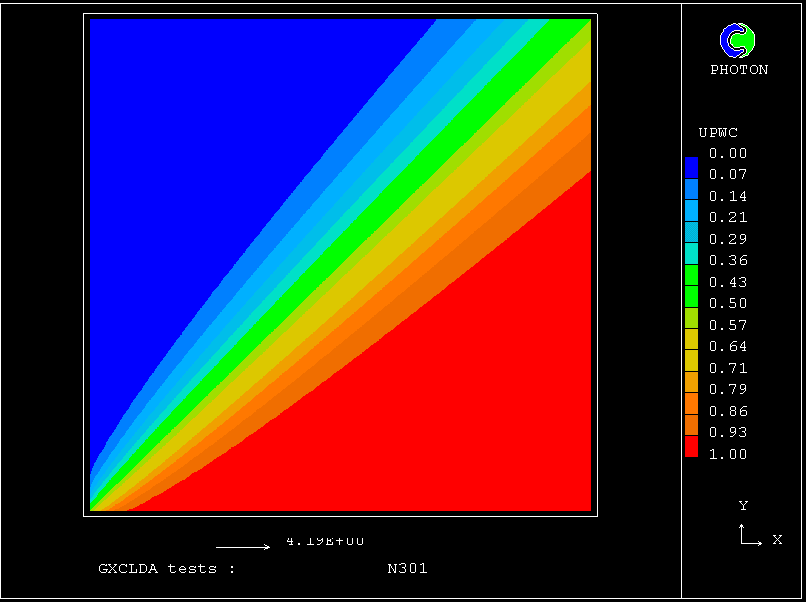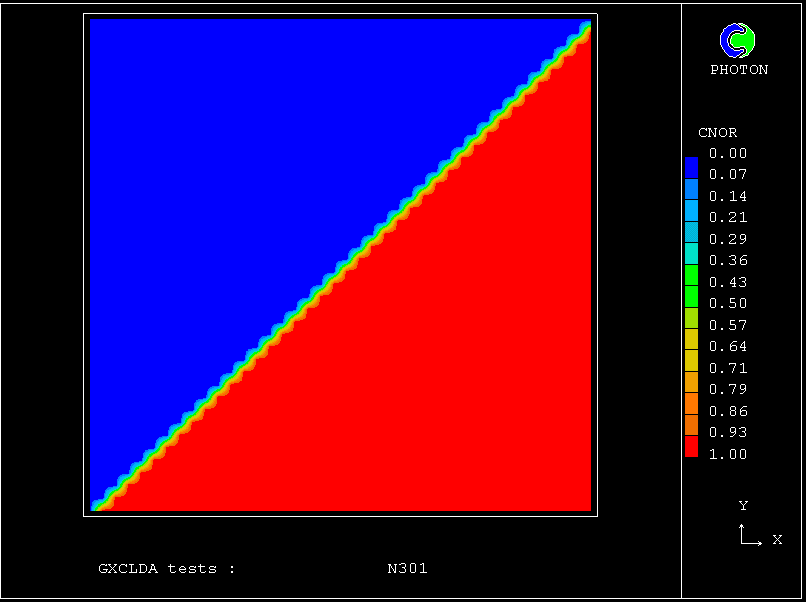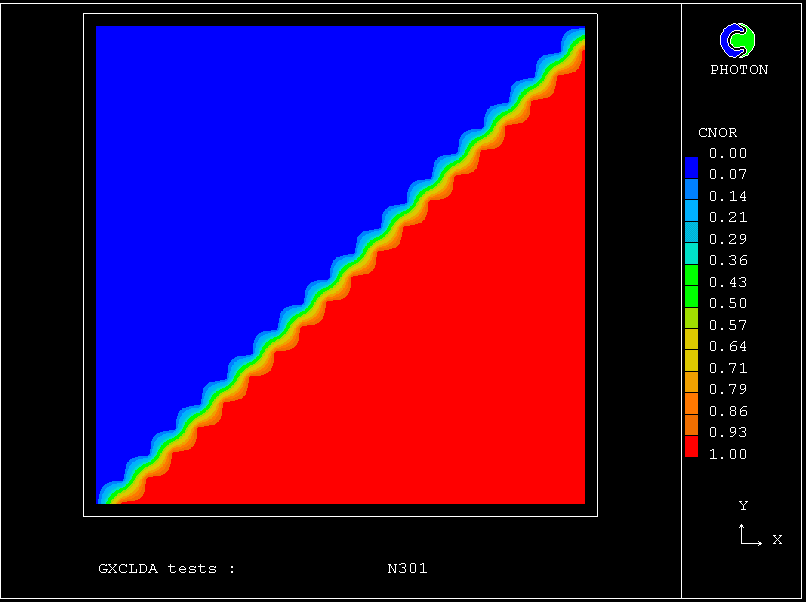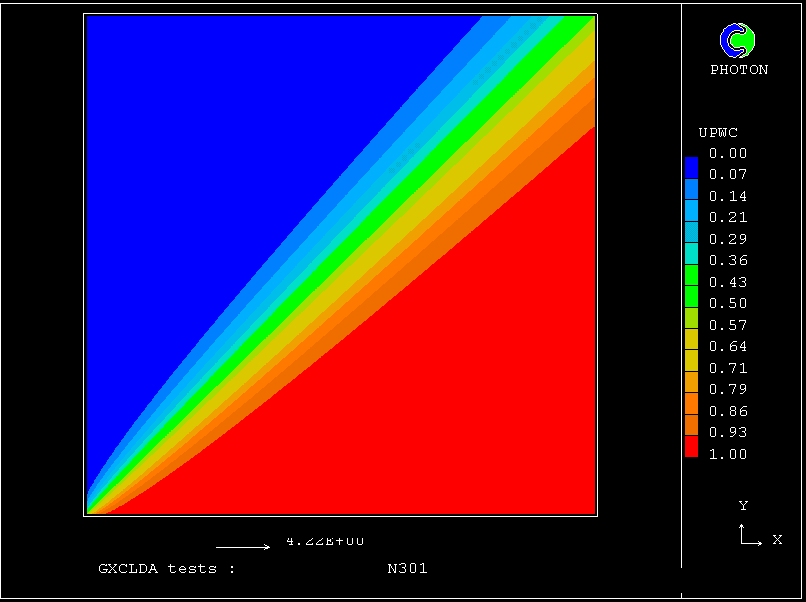
It is well known that "numerical diffusion" impairs the accuracy of solutions of the equations governing the convective transport of a scalar when the grid line are oblique to the streamlines.
Various means of reducing this impairment have been proposed; but some produce non-physical over- and under-shoots; some are not fully conservative; and some can cause the solution scheme to diverge.
No entirely satisfactory solution has ever been devised.
The CLDA is a unique-to-PHOENICS scheme which diminishes numerical diffusion without adverse effects of the above kinds; however it does not eliminate it entirely.
The first of the essential ideas is the sub-division of a rectangular cell into triangular sub-cells in the manner shown below.
If the starting grid is three-dimensional, the sub-cells become pyramids.
* * * *
* | * Ns * | *
------------|-------------------|------------
^ y * | * * | *
| * | * n * | *
| * | * * | *
| * | * * | *
| W We | w P e | Ew E
|-------> x * | * * | *
* | * * | *
* | * s * | *
* | * * | *
-------------|-------------------|------------
* | * Sn * | *
Each sub-cell has its own value of the scalar variable in question. Sub-division in this way entails that conditions in a 3D rectangular cell are represented by six values rather than by one.
If the problem is a time-dependent one, the time dimension may be sub-divided in precisely the same way. If this is done, the sub-cells take the form (if there are three space dimensions) of "four- dimensional pyramids".
Grid-refinement is a known means of reducing numerical diffusion; but it entails the penalty of an increased computer-storage requirement.
The CLDA grid can be regarded as a kind of grid refinement; and it certainly increases the storage requirement; however, the reduction in numerical diffusion brought about by the CLDA grid is much greater than can be achieved by the equivalent conventional refinement, which, in three dimensions would multiply by eight the number of rectangular cells.
The superiority results from the way in which the convection fluxes across the sub-cells are computed.
The computation of the convection fluxes will be explained by reference to a two-dimensional grid, in the north-south-east-west (i.e.) plane.
The fluxes across the diagonal faces are therefore deduced from those across the vertical and horizontal ones by simple formulae.
These fluxes, like those across the horizontal and vertical cell walls, are assumed to carry the values of the scalar which prevail on their upwind sides.
When the fluxes FS and FW are equal, which implies that the direction of fluid flow is along the south-west-to-north-east diagonal, the above formulae imply no transfer of either mass or convected scalar across that diagonal. There is therefore no numerical diffusion.
On a conventional rectangular grid, as is well known, the upwind- scalar-value assumption results in substantial numerical diffusion in such an along-diagonal flow.
The CLDA will exhibit its worst numerical diffusion for flows directed along lines bisecting the angles between the diagonals and the rectangular sides; but its magnitude is much less than the worst to which a purely rectangular grid gives rise.
When a Group 13 patch starts with the characters CLDA, and storage is allocated to appropriate additional scalar variables, the CLDA feature is activated.
The CLDA forms part of the coding supplied with the advanced- numerical-algorithm option of PHOENICS.
The coding is to be found in the file GXCLDA.FOR.
PHOENICS Input-Library case N301 concerns diagonally-directed flow across a square grid, from south-west to north-east, wherein the fluids entering through the west and south faces each have uniform but different values of a passive scalar of which the diffusion coefficient is zero.
If this problem were solved exactly, the north-west half of the grid would
be occupied by west-face fluid, and the remainder by east-face fluid; but
numerical diffusion causes extensive smearing of the interface, as is shown
here when
upwind-differencing is employed.

When the CLDA algorithm is employed, however, the solution is much closer
to the exact one, as is shown here:

Of course, it might be argued that the improvement is simply a consequence of the fact that CLDA has four times as many cells, for the same sub-division of the x and y directions (40 by 40 in the present case). However, if CLDA is used for a 20-by-20 grid, the result is still good, as shown here:

Clearly it is the manner in which the cells are sub-divided which
makes the difference, not just the number of cells. This is confirmed by
the following result from the upwind-difference scheme
when the grid is 80 by 80:

CLDA is the foundation of the X-Cell algorithm, which extends the diagonal subdivision concept to pressure and velocities.